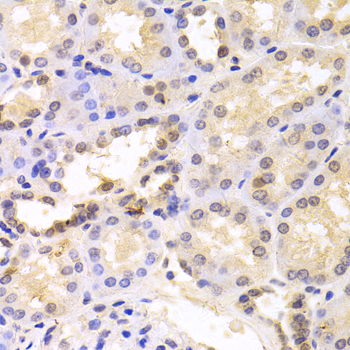Cell Biology Antibodies 9
Anti-PSMC6 Antibody (CAB5377)
- SKU:
- CAB5377
- Product Type:
- Antibody
- Reactivity:
- Human
- Reactivity:
- Mouse
- Host Species:
- Rabbit
- Isotype:
- IgG
- Antibody Type:
- Polyclonal Antibody
- Research Area:
- Cell Biology
Description
| Antibody Name: | Anti-PSMC6 Antibody |
| Antibody SKU: | CAB5377 |
| Antibody Size: | 20uL, 50uL, 100uL |
| Application: | WB IHC |
| Reactivity: | Human, Mouse |
| Host Species: | Rabbit |
| Immunogen: | Recombinant fusion protein containing a sequence corresponding to amino acids 20-150 of human PSMC6 (NP_002797.3). |
| Application: | WB IHC |
| Recommended Dilution: | WB 1:500 - 1:2000 IHC 1:50 - 1:200 |
| Reactivity: | Human, Mouse |
| Positive Samples: | NCI-H460, 293T, SH-SY5Y, Mouse liver, Mouse kidney, Mouse brain, Mouse heart, Mouse spleen |
| Immunogen: | Recombinant fusion protein containing a sequence corresponding to amino acids 20-150 of human PSMC6 (NP_002797.3). |
| Purification Method: | Affinity purification |
| Storage Buffer: | Store at -20'C. Avoid freeze / thaw cycles. Buffer: PBS with 0.02% sodium azide, 50% glycerol, pH7.3. |
| Isotype: | IgG |
| Sequence: | DKAL QDYR KKLL EHKE IDGR LKEL REQL KELT KQYE KSEN DLKA LQSV GQIV GEVL KQLT EEKF IVKA TNGP RYVV GCRR QLDK SKLK PGTR VALD MTTL TIMR YLPR EVDP LVYN MSHE DPGN VSYS EIG |
| Gene ID: | 5706 |
| Uniprot: | P62333 |
| Cellular Location: | Cytoplasm, Nucleus |
| Calculated MW: | 44kDa |
| Observed MW: | 45kDa |
| Synonyms: | PSMC6, CADP44, HEL-S-73, P44, SUG2, p42, ATPase 6 |
| Background: | The 26S proteasome is a multicatalytic proteinase complex with a highly ordered structure composed of 2 complexes, a 20S core and a 19S regulator. The 20S core is composed of 4 rings of 28 non-identical subunits; 2 rings are composed of 7 alpha subunits and 2 rings are composed of 7 beta subunits. The 19S regulator is composed of a base, which contains 6 ATPase subunits and 2 non-ATPase subunits, and a lid, which contains up to 10 non-ATPase subunits. Proteasomes are distributed throughout eukaryotic cells at a high concentration and cleave peptides in an ATP/ubiquitin-dependent process in a non-lysosomal pathway. An essential function of a modified proteasome, the immunoproteasome, is the processing of class I MHC peptides. This gene encodes one of the ATPase subunits, a member of the triple-A family of ATPases which have a chaperone-like activity. Pseudogenes have been identified on chromosomes 8 and 12. |
| UniProt Protein Function: | RPT4: The 26S protease is involved in the ATP-dependent degradation of ubiquitinated proteins. The regulatory (or ATPase) complex confers ATP dependency and substrate specificity to the 26S complex. Belongs to the AAA ATPase family. |
| UniProt Protein Details: | Protein type:Proteasome complex; Protease Chromosomal Location of Human Ortholog: 14q22.1 Cellular Component: nucleoplasm; proteasome complex; membrane; nucleus; cytosol Molecular Function:protein binding, bridging; protein binding; ATPase activity; ATP binding Biological Process: positive regulation of ubiquitin-protein ligase activity during mitotic cell cycle; ubiquitin-dependent protein catabolic process; negative regulation of ubiquitin-protein ligase activity during mitotic cell cycle; protein polyubiquitination; viral reproduction; apoptosis; antigen processing and presentation of exogenous peptide antigen via MHC class I, TAP-dependent; DNA damage response, signal transduction by p53 class mediator resulting in cell cycle arrest; regulation of apoptosis; antigen processing and presentation of peptide antigen via MHC class I; regulation of ubiquitin-protein ligase activity during mitotic cell cycle; anaphase-promoting complex-dependent proteasomal ubiquitin-dependent protein catabolic process; antigen processing and presentation of exogenous peptide antigen via MHC class I; gene expression; mitotic cell cycle; regulation of amino acid metabolic process; negative regulation of apoptosis; G1/S transition of mitotic cell cycle |
| NCBI Summary: | The 26S proteasome is a multicatalytic proteinase complex with a highly ordered structure composed of 2 complexes, a 20S core and a 19S regulator. The 20S core is composed of 4 rings of 28 non-identical subunits; 2 rings are composed of 7 alpha subunits and 2 rings are composed of 7 beta subunits. The 19S regulator is composed of a base, which contains 6 ATPase subunits and 2 non-ATPase subunits, and a lid, which contains up to 10 non-ATPase subunits. Proteasomes are distributed throughout eukaryotic cells at a high concentration and cleave peptides in an ATP/ubiquitin-dependent process in a non-lysosomal pathway. An essential function of a modified proteasome, the immunoproteasome, is the processing of class I MHC peptides. This gene encodes one of the ATPase subunits, a member of the triple-A family of ATPases which have a chaperone-like activity. Pseudogenes have been identified on chromosomes 8 and 12. [provided by RefSeq, Jul 2008] |
| UniProt Code: | P62333 |
| NCBI GenInfo Identifier: | 51702772 |
| NCBI Gene ID: | 5706 |
| NCBI Accession: | P62333.1 |
| UniProt Secondary Accession: | P62333,P49719, Q6IBU3, Q92524, B2R975, |
| UniProt Related Accession: | P62333 |
| Molecular Weight: | 389 |
| NCBI Full Name: | 26S protease regulatory subunit 10B |
| NCBI Synonym Full Names: | proteasome (prosome, macropain) 26S subunit, ATPase, 6 |
| NCBI Official Symbol: | PSMC6 |
| NCBI Official Synonym Symbols: | P44; p42; SUG2; CADP44; HEL-S-73 |
| NCBI Protein Information: | 26S protease regulatory subunit 10B; proteasome subunit p42; proteasome 26S subunit ATPase 6; conserved ATPase domain protein 44; epididymis secretory protein Li 73; 26S protease regulatory subunit S10B; 26S proteasome AAA-ATPase subunit RPT4 |
| UniProt Protein Name: | 26S protease regulatory subunit 10B |
| UniProt Synonym Protein Names: | 26S proteasome AAA-ATPase subunit RPT4; Proteasome 26S subunit ATPase 6; Proteasome subunit p42 |
| Protein Family: | 26S protease regulatory |
| UniProt Gene Name: | PSMC6 |
| UniProt Entry Name: | PRS10_HUMAN |








